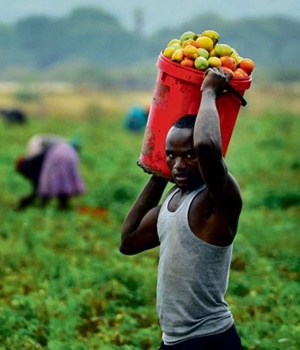
A partnership between the IDC and the Unemployment Insurance Fund is helping to retain and create employment
One has a huge and growing surplus of funds meant to combat the effects of unemployment. The other has a queue of potentially job-creating businesspeople outside its doors, clamouring for capital.
The five-year arrangement between the Unemployment Insurance Fund (UIF) and the Industrial Development Corporation (IDC) could mark the beginnings of a new model for development finance in South Africa.
Since 2010, the UIF has bought R4 billion in bonds from the IDC, money the lender has loaned to businesses. The money has been made available to IDC-funded companies at discounted interest rates with one quid pro quo: create or save jobs at less than R450 000 a head.
The idea came from Brazil, where the Brazilian Development Bank is funded by the Workers’ Assistance Fund.
The IDC was looking at something similar in 2008 with the start of the economic crisis, making the case for new funding sources more compelling.
Lerato Mangope, head of corporate finance at the IDC, says: “It was right in the middle of the economic crisis; the cost of capital was very high, companies were folding and huge industries were coming to the IDC.”
It took two years to iron out a workable arrangement because the UIF had “mandate constraints”.
The UIF’s annual surplus usually goes to the Public Investment Corporation (PIC), from which it has to get a certain yield in lending out the money.
But the IDC arrangement involves a concession on interest rates.
To make up for this, the money has to make a demonstrable impact in the UIF’s sphere of concern: unemployment.
There have already been two sets of R2 billion bonds, with a third in the pipeline.
Though not overwhelming in terms of the IDC’s total portfolio, the funding has demonstrated how state entities with relatively idle funds can channel them into investments.
This funding made up 17% of the IDC’s debt financing at the end of March this year.
More importantly, it plays a specific role due to the low interest rate that comes with it and its very simple and stringent criteria.
The main criterion is jobs.
Any applicant for funding from the UIF pool needs to show their project will create or save jobs at a cost of below R450 000 a head.
Practically, this means that very capital-intensive borrowers are excluded. The initial limit of R100 million a client was also reduced to R50 million to spread the money as widely as possible.
Nevertheless, it has become a powerful addition to the IDC’s arsenal because it allows the lender to give clients new concessional interest rates.
The interest rates are low, with the IDC getting the UIF money at about 5%. More importantly, the IDC lends it on at only 1% more, cutting the usual fees.
There is an understanding that the IDC will not profit from the concessionary funding, but pass on the cheap funding, says Mangope.
The UIF funding was essentially used to reduce the cost of funding to clients.
“If a client had to borrow, say, R100 million, from the IDC and they qualify under the criteria, they could get R50 million from the UIF. The weighted average interest rate then falls.
“If your loan is R25 million, you could get all of it on UIF terms,” she says. “People tend to come in and say they want UIF and UIF only.”
The loans have evidently performed well.
According to Mangope, the impairment rate on UIF fund loans is only 6%, compared with more than 16% for the whole IDC portfolio of loans.
In other words, they are paid back.
The project is also delivering job statistics to justify the small hit on its income that the PIC is taking.
In total, as of March this year, 32 741 jobs were created and 21 644 were saved. This after 258 deals were fully or partially funded with UIF money.
These outcomes are key to the UIF remaining a funder, which means the job statistics are rigorously scrutinised, says Mangope.
And there is a penalty if it is found that a client has not diclosed the correct information.
When clients report back, the jobs numbers are audited. If they don’t tally, the IDC department responsible for approving the funding is also penalised. The IDC’s bonus system hinges on these reviews.
Mangope says people can be very creative when trying to dupe the system.
If clients are found to have hoodwinked the IDC and misrepresented the jobs potential of an investment, they are penalised.
If they have not adhered to the criteria, and cannot justify their actions, they are slapped with a punitive default rate on their debts to the IDC.
“It is not as bad as the microlenders – it’s not going to go to 25%, but you could find that if you are paying 5%, it could rise to 11%. If you are not compliant, you are in trouble,” says Mangope.
This often happens with IDC clients, but very seldom with UIF-funded projects.
“The rate is so cheap and, if you are saving a company, there is adherence. There is very little deviation from the norm.”
As far as the IDC is concerned, the arrangement should continue, says Mangope.
“To us as two government agencies that drive the National Development Plan and the Industrial Policy Action Plan, it makes sense. So why not do it together?
“We have achieved quite a lot. As the IDC, we would love it [if the UIF funding became permanent], but it is not up to us.
“They have their own board and their own mandate, but we will always chase them for it.”
The UIF is bound to use its funds to provide the statutory unemployment insurance it was created for, with some leeway to put, at most, 10% of its R113 billion in assets into “developmental investments”.
“I spoke to the commissioner [of the UIF, Boas Seruwe]. He says he likes our relationship,” says Mangope.
The UIF is not the only large pot of insurance fund money controlled by a government agency. Another possibility may lie with the Compensation Fund, which falls under the department of labour, just like the UIF.
Mangope says a similar arrangement with that fund could be worth exploring.
“What is in it for them? It has to fit their mandate for compensation.”
The IDC could very well channel money from that fund into hospitals or medical-supply manufacturing that directly suits their mandate, says Mangope.
The days of associating the Unemployment Insurance Fund (UIF) with chaos, bad audit reports and maladministration have been replaced with clean books, accountability and, more importantly, job creation and preservation.
Thanks to the partnership between the UIF and the Industrial Development Corporation (IDC), several companies have been able to preserve and create about 54 000 jobs in the past five years.
UIF commissioner Boas Seruwe says after he and his management team managed to turn things around at the fund, they started looking to add value to the economy.
“After the effects of the 2008 global financial crisis, we embarked on a plan to alleviate the effects of unemployment. We came up with funding the wages of companies in distress. We reskilled people who had lost their jobs and made them ready for the workplace, and we were investing in JSE-listed companies via the Public Investment Corporation. So we decided to give money to unlisted companies.”
Seruwe says that in 2010, the fund gave the IDC about R2 billion to lend to unlisted companies to create and preserve jobs. The UIF had instructed the IDC to invest the money in start-ups and companies that wanted to expand their operations.
“Within a short space of time, it was a success and we started getting good results. After two years, we expanded the project by investing another R2 billion in the IDC. All the funding has been allocated and we are quite happy with what we have achieved. We’re looking at working with the IDC again.”
Seruwe says when the programme started, the interest rate on loans to the IDC was 5%.
This was linked to the inflation rate at the time, he adds. A 5% interest rate is low, as commercial banks peg their rates to inflation and add their own charges, depending on the client’s risk profile. Commercial banks charge up to 11%, but when the programme continued in 2012, the interest rate was reduced to 4%.
“We instructed the IDC to, at the very least, return our capital. And they have done that. The return for us is creating and preserving jobs. We have been able to do that.
This project is reported by City Press and sponsored by the IDC




 Publications
Publications
 Partners
Partners








